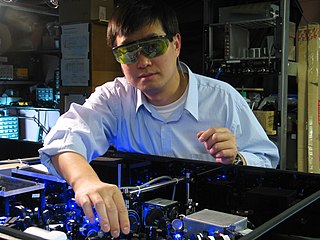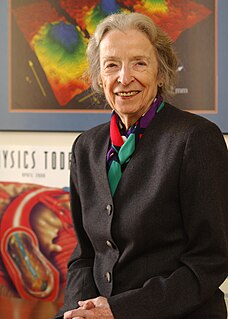Related Research Articles
The American Physical Society (APS) is a not-for-profit membership organization of professionals in physics and related disciplines, comprising nearly fifty divisions, sections, and other units. Its mission is the advancement and diffusion of knowledge of physics. The society publishes more than a dozen scientific journals, including the prestigious Physical Review and Physical Review Letters, and organizes more than twenty science meetings each year. APS is a member society of the American Institute of Physics. Since January 2020 the organization is led by chief executive officer Jonathan Bagger.

Eric Allin Cornell is an American physicist who, along with Carl E. Wieman, was able to synthesize the first Bose–Einstein condensate in 1995. For their efforts, Cornell, Wieman, and Wolfgang Ketterle shared the Nobel Prize in Physics in 2001.
Deborah Shiu-lan Jin was an American physicist and fellow with the National Institute of Standards and Technology (NIST); Professor Adjunct, Department of Physics at the University of Colorado; and a fellow of the JILA, a NIST joint laboratory with the University of Colorado.

John Lewis "Jan" Hall is an American physicist, and Nobel laureate in physics. He shared the 2005 Nobel Prize in Physics with Theodor W. Hänsch and Roy Glauber for his work in precision spectroscopy.

Alexander Dalgarno FRS was a British physicist who was a Phillips Professor of Astronomy at Harvard University.
Markus Greiner is a German physicist and Professor of Physics at Harvard University.

David Jeffrey Wineland is an American Nobel-laureate physicist at the National Institute of Standards and Technology (NIST) physics laboratory. His work has included advances in optics, specifically laser-cooling trapped ions and using ions for quantum-computing operations. He was awarded the 2012 Nobel Prize in Physics, jointly with Serge Haroche, for "ground-breaking experimental methods that enable measuring and manipulation of individual quantum systems".

Ana Maria Rey is a Colombian theoretical physicist, professor at University of Colorado at Boulder, a JILA fellow, a fellow at National Institute of Standards and Technology and a fellow of the American Physical Society. Rey was the first Hispanic woman to win the Blavatnik Awards for Young Scientists in 2019.

Jun Ye is a Chinese-American physicist at JILA, National Institute of Standards and Technology, and the University of Colorado Boulder, working primarily in the field of atomic, molecular and optical physics.

Katharine Blodgett Gebbie was an American astrophysicist and civil servant. She was the founding Director of the Physical Measurement Laboratory of the National Institute of Standards and Technology (NIST), and of its two immediate predecessors, the Physics Laboratory and the Center for Atomic, Molecular and Optical Physics, both for which she was the only Director. During her 22 years of management of these institutions, four of its scientists were awarded the Nobel Prize in Physics. In 2015, the NIST Katharine Blodgett Gebbie Laboratory Building in Boulder, Colorado was named in her honor.
Martin Zwierlein is a professor of physics at Massachusetts Institute of Technology and an Elected Fellow of the American Physical Society.
Nora Berrah is an Algerian physicist who studies how light and matter interact. She is a professor at the University of Connecticut, where she previously was chair of the physics department.

Heather Lewandowski is a Professor of Physics at the University of Colorado Boulder. She looks to understand the quantum mechanical processes in making chemical bonds. She uses time-varying inhomogeneous electric fields to achieve supersonic cooling. She also studies how students learn experimental skills in instructional physics labs and help to improve student learning in these environments. She is a Fellow of the American Physical Society.
Cindy A. Regal is an American experimental physicist most noted for her work in quantum optics; atomic, molecular, and optical physics (AMO); and cavity optomechanics. Regal is an associate professor in the Department of Physics at the University of Colorado and JILA Fellow; and a Fellow of the American Physical Society (APS).
Monika Schleier-Smith is an American experimental physicist studying many-body quantum physics by precisely assembling systems of ultracold atoms. These atomic, molecular, and optical physics (AMO) engineered systems have applications in quantum sensing, coherent control, and quantum computing. Schleier-Smith is an Associate Professor of Physics at Stanford University, a Sloan Research Fellow, and a National Science Foundation CAREER Award recipient. Schleier-Smith also serves on the board of directors for the Hertz Foundation.
The I. I. Rabi Prize in Atomic, Molecular, and Optical Physics is given by the American Physical Society to recognize outstanding work by mid-career researchers in the field of atomic, molecular, and optical physics. The award was endowed in 1989 in honor of the physicist I. I. Rabi and has been awarded biannually since 1991.
Randall M. Feenstra is a physicist.
Deborah Kay Watson is an American physicist known for her work on the many-body problem in quantum mechanics. She is a professor emerita of physics at the University of Oklahoma.
Lucy Marie Ziurys is an American astrochemist known for her work on high-resolution molecular spectroscopy. She is Regent's Professor of Chemistry & Biology and of Astronomy at the University of Arizona.
References
- 1 2 3 4 "Purdue physics, astronomy professor elected to prestigious National Academy of Sciences" (Press release). Purdue University. 30 April 2019.
- 1 2 "Christopher Henry Greene". Physics history Network. American Institute of Physics. Retrieved 25 September 2019.
- ↑ Greene, Chris H. (1981). "Doubly excited states of the akaline-earth atoms". Physical Review A. 23 (2): 661–678. Bibcode:1981PhRvA..23..661G. doi:10.1103/PhysRevA.23.661. ISSN 0556-2791.
- ↑ "2010 Davisson-Germer Prize in Atomic or Surface Physics Recipient". American Physical Society. Retrieved 25 September 2019.
- ↑ "Proceedings of the American Physical Society". APS Physics History.
- ↑ "APS Fellow Archive". APS Fellow Archive.
- ↑ "Rabi Prize in Atomic, Molecular, and Optical Physics". APS Physics.
- ↑ "In the News 2018-2019". Miller Institute Miller News.
- ↑ "2010 Davisson-Germer Prize". APS Physics.
- ↑ "Giant Molecules Win Purdue Professor the Hamburg Prize". Purdue University.